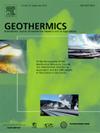液氮循环冲击下干热岩石破裂过程的实时热响应表征
IF 3.5
2区 工程技术
Q3 ENERGY & FUELS
引用次数: 0
摘要
循环液氮(LN2)压裂技术显著提高了干热岩地热储层的改造性能。本文研究了LN2循环热冲击作用下干热岩石的实时热响应特征。利用声发射技术捕捉了不同加热温度下LN2循环冲击下HDR内部裂纹的动态演化和实时破裂行为。讨论了HDR在LN2循环冲击下的损伤机理和裂纹发展过程。结果表明,在LN2冷却初期,HDR表面与液氮之间的极端温差导致热应力急剧增加,产生显著的损伤效应,声发射能量出现峰值。在冷却中后期,在加热温度为200℃和300℃时,声发射活动最小,而在加热温度为400℃时,声发射能量较高。300℃-400℃是加热- LN2快速冷却条件下HDR损伤特性发生显著变化的温度阈值区间。此外,300℃时总循环次数的累积能量比200℃时高46.2%,400℃时比200℃和300℃时分别高186.9%和96.2%。随着加热温度的升高和循环次数的增加,HDR的破坏程度逐渐增大。LN2冷却过程主要表现为剪切损伤,在较高加热温度下出现少量拉伸损伤。本文章由计算机程序翻译,如有差异,请以英文原文为准。
Characterization of real-time thermal response during rupture of hot dry rock under the shock of liquid Nitrogen circulation
Circulating liquid nitrogen (LN2) fracturing technology significantly enhances the remodeling performance of geothermal reservoirs in hot dry rock (HDR). This study examines the real-time thermal response characteristics of hot dry rock subjected to thermal shock from the LN2 cycle. The dynamic evolution and real-time rupture behavior of internal cracks in HDR under LN2 cycle impacts at varying heating temperatures are captured using acoustic emission technology. The damage mechanism and crack development process of HDR under the LN2 cycle shock are discussed. Findings indicate that during the early stage of LN2 cooling, the extreme temperature differential between the HDR surface and liquid nitrogen induces a sharp increase in thermal stress, resulting in notable damage effects, peak acoustic emission energy counts occur. In the middle and late stages of cooling, acoustic emission activity is minimal at heating temperatures of 200 °C and 300 °C, while at 400 °C, high acoustic emission energy is observed. 300 °C-400 °C is the temperature threshold interval for significant changes in damage characteristics of HDR under heating- LN2 rapid cooling conditions. Additionally, the cumulative energy of the total number of cycles at 300 °C is 46.2 % higher than at 200 °C, and at 400 °C, it is 186.9 % and 96.2 % higher compared to 200 °C and 300 °C, respectively. The degree of damage to HDR escalates with increasing heating temperature and cycle number. The LN2 cooling process primarily manifests as shear damage, with small amount of tensile damage occurring at higher heating temperatures.
求助全文
通过发布文献求助,成功后即可免费获取论文全文。
去求助
来源期刊

Geothermics
工程技术-地球科学综合
CiteScore
7.70
自引率
15.40%
发文量
237
审稿时长
4.5 months
期刊介绍:
Geothermics is an international journal devoted to the research and development of geothermal energy. The International Board of Editors of Geothermics, which comprises specialists in the various aspects of geothermal resources, exploration and development, guarantees the balanced, comprehensive view of scientific and technological developments in this promising energy field.
It promulgates the state of the art and science of geothermal energy, its exploration and exploitation through a regular exchange of information from all parts of the world. The journal publishes articles dealing with the theory, exploration techniques and all aspects of the utilization of geothermal resources. Geothermics serves as the scientific house, or exchange medium, through which the growing community of geothermal specialists can provide and receive information.
 求助内容:
求助内容: 应助结果提醒方式:
应助结果提醒方式:


